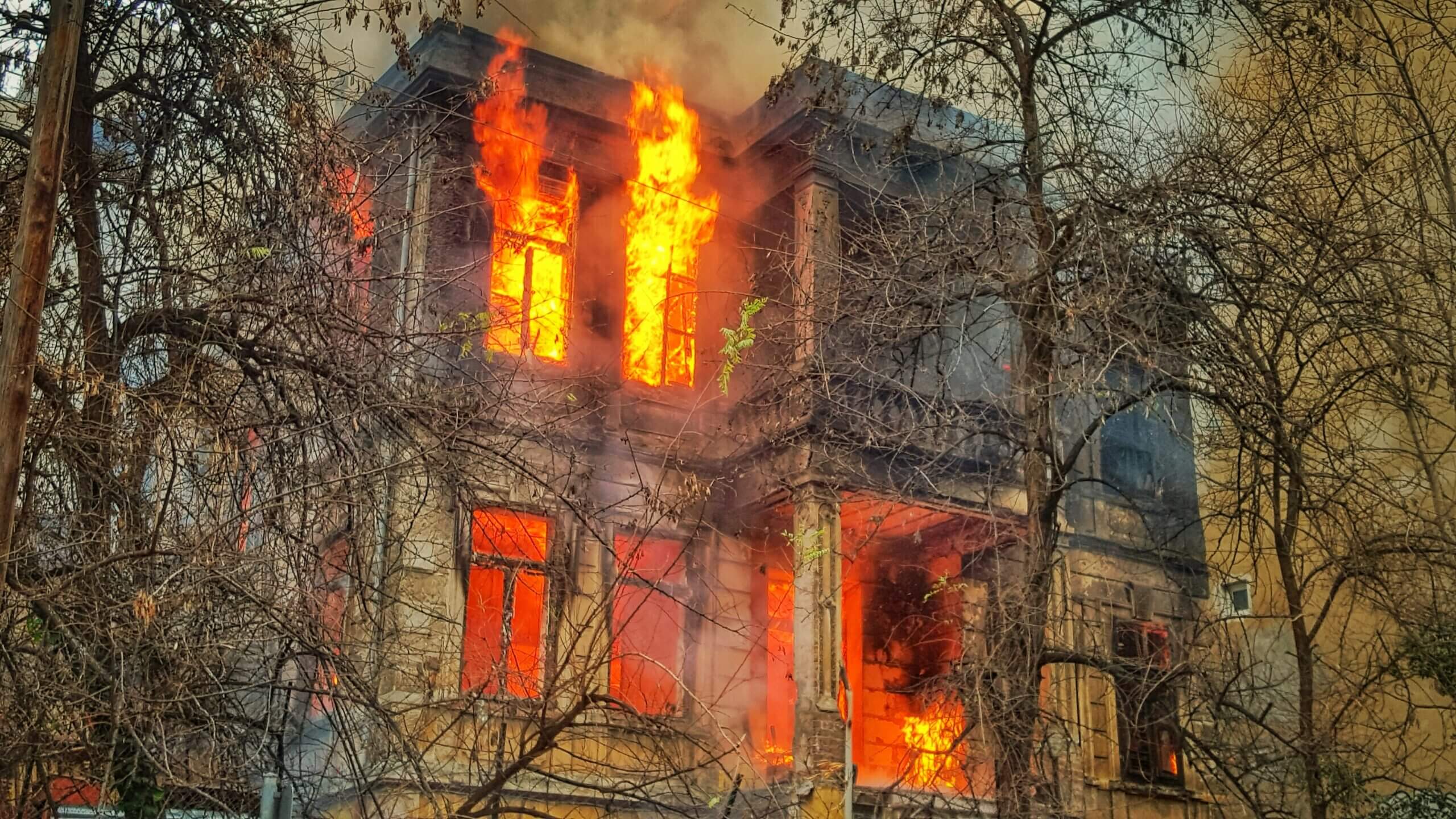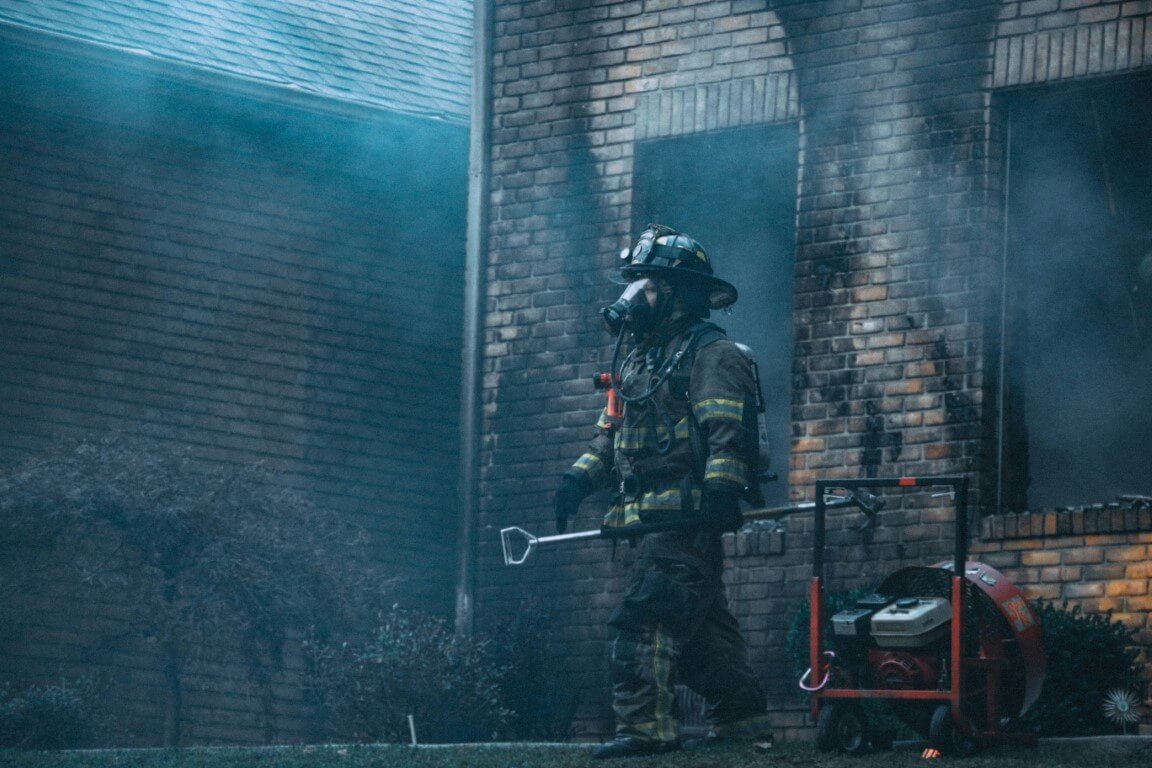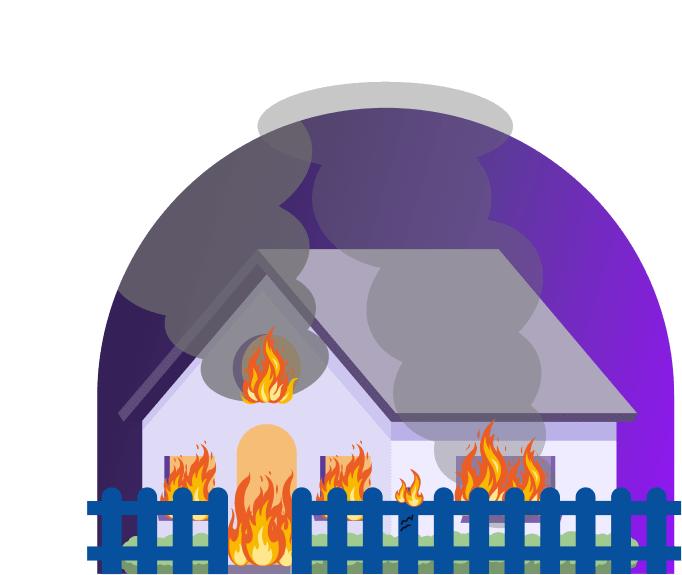What Is Fire Damage Restoration?
When we think about fires, we often think of an entire home destroyed by the flames, leaving only the charred skeleton behind. But in most cases, a fire in the home will do significant damage yet leave the home standing, ready for cleanup and repairs. Fire damage includes not only the burned areas, but the soot and smoke spread by the fire.
Fire damage restoration includes assessing that damage, cleaning and deodorizing household items, repairing any damaged areas, mitigating any water damage, and rebuilding after the fire. The restoration process aims to return the property to its original condition, ensure the structural integrity, and improve the air quality.
What it takes to restore the home depends on a variety of factors, including the type of fire it was, how much structural damage it did, mitigation factors (such as water from firefighting hoses), and more. Here’s what you need to know if a fire occurs in your home.

Is Professional Fire Damage Restoration Really Necessary?
The primary damage from a fire comes from the flames. Depending on where the fire began, even a small burned area could indicate structural weakening — not to mention the damage to walls, flooring, and more.
Even a small fire can generate astounding amounts of smoke and soot. That secondary damage can create odors you can’t air out. The water used to put out the fire can also cause problems of its own, including mold growth.
Though you can do some cleanup on your own, hiring a professional is the only way to be certain that the hidden problems — such as that potential mold growth — are handled properly. Besides that, often insurance companies will require fire restoration by a professional and won’t cover the claim if you tackle the work yourself.
Average Cost of Fire Damage Restoration
Most people spend anywhere from $3,107 to $51,243 for fire damage restoration, with the national average sitting at $27,175.
Though those numbers seem pretty steep, keep in mind that the top end of that range is usually restoration of a completely gutted home. The damage from smaller fires that are contained to one area of the home is usually much easier to clean up.
Your local labor costs drive the restoration cost as well. If you live in an area where these services are in high demand, expect to pay a premium.
As a good rule of thumb, consider that damage from a small, contained fire can cost between $3,000 and $10,000 in restoration costs, while a moderate fire affecting several rooms can run up to $30,000. A major fire that requires rebuilding most of the home will run between $30,000 and $70,000 or more.
What you actually pay will depend not only on the extent of the damage and the size of the damaged area, but your insurance coverage as well. In some cases, you will be responsible only for the deductible. However, check the fine print, as some companies might cover the cleaning and repair but not cover anything concerning smoke damage or replacing the damaged contents of your home.
Cost by Location or Project Type
You might see higher costs depending on how bad the fire was, where it started and how far it spread, the smoke and soot damage that spread throughout the home, and even the water damage from the fire-fighting efforts. Here’s how these different costs break down.
Smoke and Soot Damage
Besides the damage from the flames, smoke and soot are some of the most serious problems you’ll face in the aftermath of a fire. Soot is a fine black powder filled with carbon particles and other chemicals that go airborne during a fire. Soot can not only lead to discoloration and unpleasant odors in the home, it can also lead to serious damage to electronic devices, household furniture and materials, and can even corrode metals. The longer soot is allowed to remain on a surface, the more damage it does.
Smoke brings compromised air quality and an uncomfortable odor that permeates everything, even items on the other side of the home from where the fire began. Both smoke and soot can lead to serious long-term health problems for the occupants of the home, so it’s vitally important to hire professional services to clean up as soon as you can after the home is cleared by the fire department.
Cleaning up smoke and soot damage can run from $200 on the low end to over $6,000 on the high end.
Water Damage Cleanup
There are a few ways you can wind up with serious water damage after a fire. The first is obvious: when the fire department comes to put out the fire, they usually use hoses that deliver many gallons of water to douse the flames. That water often winds up as part of the cleanup process after the devastation is over. If you happen to have a sprinkler system, you can count on the same problem in the aftermath.
But you can also have serious water damage even if you were able to put out the fire without the help of professionals. Heat causes damage to water lines, which can lead to leaks or bursting. In the chaos of a fire, it might take some time before you realize you have a leak.
Water damage cleanup requires removing the standing water, drying out all materials, cleaning, and sanitizing the area to avoid any mold growth in the future. Since mold can start growing as little as 24 hours after the fire, it’s important to get help right away.
As a general rule of thumb, water damage cleanup costs usually run between $1,000 and $6,000.
Odor Removal and Deodorizing
Even if you are able to salvage many of your personal belongings, you face another problem: Smoke. The lingering scent of smoke is not only annoying, but could actually make you sick. The good news is that advanced techniques can alleviate the smell. Your fire damage restoration expert can help you choose the right method for your situation.
| Cleaning Method | Cost Range |
|---|---|
| Furniture and textile deodorizing | $200 to $1,000 |
| Thermal fogger | $200 to $600 |
| Ozone treatment | $400 to $600 |
Rebuilding and Structural Repairs
The cost of rebuilding and structural repairs is dependent upon just how bad the fire was. For example, making repairs after a small kitchen fire might run you up to $10,000, but the repairs and rebuilding required by a fire that gutted the entire kitchen and the dining room for good measure can run more than $50,000.
Cost Factors That Influence Price
Fire damage mitigation costs vary widely depending on how bad the fire was and what parts of the home were damaged. Here are some of the estimated costs for the various components of your home that might have been damaged.
| Type of Fire | Restoration Cost |
|---|---|
| Standard combustible fire | $9,000 to $14,000 |
| Cooking fire | $12,000 to $20,000 |
| Electrical fire | $12,000 to $23,000 |
| Gas fire | $14,000 to $20,000 |
| Combustible metal fire | $16,000 to $25,000 |
Size of Affected Area
The larger the area of your home that suffered fire damage, the more expensive the project will be. That accounts for more labor as the hours add up, more materials to restore, and more area to deodorize or dry out. Expect an average of $5.50 per square foot to restore the damage, with most paying between $4 and $7 per square foot.
Type and Severity of Fire
The type of fire you had in your home can also determine how much things will cost. That’s because different types of fires bring different problems. For instance, an electrical fire is more likely to cause heavy damage, but cooking fires and gas fires come in a close second. Here are the five categories of fires, as determined by the Fire Equipment Manufacturers’ Association:
| Work Required for Restoration | Cost Range |
|---|---|
| Kitchen repairs (counters cabinets etc) | $14,600 to $41,300 |
| Installation of new drywall | $1,000 to $3,000 |
| Roof repairs | $5,900 to $12,800 |
| Foundation repairs | $2,200 to $7,800 |
| New electrical wiring | $900 to $3,000 |
| Floor repairs | $400 to $20,000 |
Materials Affected
With some fires, you might get lucky – you might have damage to the cabinets in your kitchen, let’s say, but no damage to your floors. However, most structural fires damage all the basic elements of the home in some way. The cost of your damage restoration will depend on the different elements damaged, such as drywall, flooring, wiring, or even plumbing.
Accessibility
Any area that is difficult for professionals to reach can drive up your costs. Hard-to-reach areas, such as crawl spaces or basements, can require specialized equipment and additional labor for restoration, which can drive your price up.
Labor Rates by Region
The vast majority of the costs of fire restoration go toward labor. This includes everything from airing out the home and deodorizing items to working on rebuilding damaged areas of the home. The labor rates will be based on your area; those who live in major cities and coastal states will likely pay more than those who live in rural areas or the Midwest.
Time to Emergency Response
How long it takes emergency crews to reach your home plays a big role in just how bad the fire becomes. Once the crews get there, you also face water and chemical damage from the process of fighting the fire. The sooner the emergency vehicles get to the scene, the more affordable your fire restoration costs will be.
Additional or Hidden Costs
Fire restoration costs are the start, but there will be other costs as well. Temporary housing might be a necessity, and that could go on for weeks or even months. You will need to pay your insurance deductible, assuming that your insurance policy will cover the fire event.
If you opt for high-end materials or changing the layout of your home after a serious fire, you could see costs that your insurance won’t cover. You might also have permits required by your local municipality, no matter what sort of rebuilding work you are doing — often permits are required to ensure that the house is inspected and deemed habitable after fire damage restoration.
Finally, consider specialty restoration costs for things that matter to you. This might include electronics, musical instruments, paintings and other fine artwork, high-end clothing, and antiques. These restoration costs can add up quickly.
DIY vs. Hiring a Professional
Some fire damage cleanup can be handled by confident DIYers, but there are times it’s best to hire a pro. Here’s how to tell the difference:
DIY Fire Damage Cleanup
Recovering from a small fire that resulted in minor smoke damage but little else is a perfect DIY job. Deep cleaning and deodorizing, using heavy-duty products from your local home improvement store, can be a weekend project that makes your home smell good as new.
Professional Fire Restoration Services
Anything more than minor smoke damage requires professional assistance. This is especially true if your home suffered significant fire damage and the resulting water damage from stopping the fire. A fire restoration company can catch structural damage you might miss, moisture that needs to be cleared out, and even unsafe conditions that could make your home unlivable while the work is taking place.

How to Save Money on Fire Damage Restoration
There are some ways you can save money on fire damage restoration. It starts with homeowners’ insurance. Work closely with your insurance agent to understand what your policy covers. Though you will have to pay the deductible, the insurance company should take care of the rest. Ask your agent what you can do in your particular situation to bring costs down.
Some contractors will allow you to bundle services, such as rolling deodorizing services and soot cleanup together for a discount.
There are some small things you can do yourself that might save on hourly labor costs, such as cleaning up debris and airing out the property.
Finally, always compare bids from contractors. At least three quotes is great — and make sure the contractors are bidding on the same parameters to ensure you can compare the bottom line. Look at the professional’s reputation and experience in the area of fire restoration to choose the best contractor for you.
Long-Term Value or Impact
Fire damage restoration is usually the cost-effective route, especially if the home hasn’t suffered severe damage. If the fire affected a room or two, restoring is the way to go.
The restoration can give you peace of mind in the safety of your home. It might also boost the value of your home to something greater than it was before the fire began, thanks to replacements and upgrades as the restoration occurs. You might see insurance benefits as well, especially if the materials used in restoration are fire-resistant.
In the event of a fire, it’s important to act quickly to repair the damage. This guide will explain what you may have to pay for fire damage restoration.
